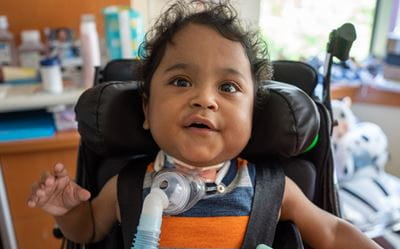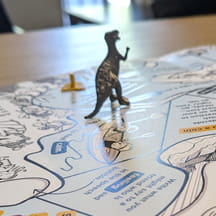Ana Rivera found out she was pregnant on Halloween in 2020. She and her partner, Diana Vasquez, started preparing for the next chapter in their lives and their new arrival. However, at just 26 weeks’ gestation, River Omari Rivera was born weighing a mere 2.2 lbs. and measuring just 14 inches long. Rivera and Vasquez found that he barely fit in their hands, comparing him to the size of a water bottle. They were afraid to touch him for fear of hurting him.

breathing on his own thanks to support from Blythedale Children’s.
As a micro-preemie, River was diagnosed with severe bronchopulmonary dysplasia, and he required mechanical ventilation to breathe. “The way it was explained to us was that he could not open and close his lungs,” says Vasquez. “Normally, in kids with his condition, they don’t survive, and they were trying to give us the reality of our circumstance.”
After seven months in the NICU, River was admitted to Blythedale Children’s Hospital in Valhalla, New York, for comprehensive pulmonary rehabilitation and post-acute neonatal care. “The NICU nurses instilled in us that life was going to start once we got to Blythedale,” says Vasquez. “‘They’re going to give you the tools that you need to take your child home.’”
At Blythedale Children’s Hospital, where more than a third of the patients are admitted for intensive pulmonary rehabilitation, there is an entire clinical care team dedicated to helping children breathe. When River arrived, his end tidal carbon dioxide (ETCO2) levels were in the 100s, more than double the normal range of 35 to 45. And his positive end-expiratory pressure (PEEP) was at 14, almost three times the normal number.
River’s respiratory therapists, medical team and rehabilitation therapists helped him continue to grow. Each day, River would receive comprehensive therapies, including physical, occupational, speech and feeding therapies, as well as developmental support to help him reach important milestones. “It made me feel comfortable to watch the therapists and teachers work with River. To watch them, it took the fear of the tubing away,” says Vasquez. “We realized he can do everything a regular child does, he just has an extra attachment.”
Through Blythedale Children’s comprehensive Parent and Family Education Program, Rivera and Vasquez learned how to care for River in the new simulation lab, composed of high-tech spaces that replicate bedside and home environments where parents can learn how to care for their medically fragile child in a supportive, controlled environment in preparation of their discharge home. They also trained with a Parent and Family Education coordinator to learn how to change River’s gastrostomy and tracheostomy tubes, and how to set up their own at home.
On September 8, at about one and a half years old, River was discharged home, breathing on his own, requiring supplemental oxygen only at night. “It’s still a journey,” says Rivera. “But we’re home and we can be a family as one.”
The original version of this story was published by Blythedale Children’s Hospital.


